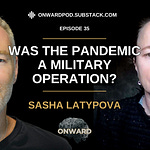In this podcast lawyer Lisa Miron joins me again after our previous podcast “Pandemic Prevention or Power Grab?” were we discussed Bill C293 in Canada. Today we unpack the Food Chain Reaction tabletop exercise. This exercise is one of a long list of simulation exercises that governments, subject matter experts and NGO’s have conducted over the years. Perhaps the most famous of these exercises is “Event 201”. Event 201 took place in Nov 2019. From the event summary:
“Event 201 simulates an outbreak of a novel zoonotic coronavirus transmitted from bats to pigs to people that eventually becomes efficiently transmissible from person to person, leading to a severe pandemic. The pathogen and the disease it causes are modelled largely on SARS, but it is more transmissible in the community setting by people with mild symptoms”
What happened a few short months later was exactly what was outlined in Event 201: A coronavirus pandemic. The million dollar question is “was this a simulation exercise or a planning session for things to come?”.
But there have been many other simulation exercises. If you have never looked at these before, you should check them out. The parallels to what we have seen play out in real life are often eerie.
It is important to point out that the common actors involved in organizing and funding these tabletop exercises include the Johns Hopkins Center for Health Security, various U.S. government agencies (such as the Department of Health and Human Services and Department of Homeland Security), and private foundations like the Bill & Melinda Gates Foundation and George Soros’ Open Society Foundations, often collaborating with international organizations like the World Health Organization (and by extension the NGO’s funding them).
While I understand that these types of exercises are important to prepare for emergencies and threats, it also raises questions about how much is actual preparedness and how much is planning or dress rehearsal for pre-planned emergencies. The Covid-19 pandemic is exhibit A in this regard where we saw testing kits being shipped out before any emergency was declared, the “discovery” and distribution of never-done-before mRNA injections (the “speed of science”), and the swift, unified narrative control by mainstream media; dismissing any questions as conspiracy theories and misinformation.
Food Chain Reaction: A Global Food Security Game
The Food Chain Reaction was a global simulation exercise held in 2015 to explore the effects of climate change, population growth, and political instability on the global food supply from 2020 to 2030; broken up into 4 time frames, each with sketched out their specific scenarios and narratives.
The game involved representatives from national governments, international organizations, multilateral institutions and business investors, who worked through food shortages, price spikes, extreme weather events, and social unrest. The primary focus was on testing the coordination of international responses and examining how policies can stabilize the global food system.
Important point here: much of what was sketched out in this fictitious exercise has actually happened in real life. Lisa and I go through this in great detail in the podcast and look up some of these things in real time during our discussion.
Now, I want to be very clear: I am not suggesting that each and every facet of this exercise has been pre-planned. I am also not suggesting that everything in this exercise will manifest in real life.
In Summary
Zooming back out and viewing all of these simulation, tabletop exercises raises some significant concerns (especially when one considers the accurate “predictiveness” of both the Event 201 and the SPARS Pandemic exercises).
Remember, many the institutions and organizations funding and running these exercises also stand to profit from emergencies. I have covered this extensively in my work over the past few years. You can read more about that here and listen to one of many podcasts I’ve done with James Roguski on the subject:
Is the pandemic treaty dead?
My guest today is James Roguski, a vigilant researcher and advocate, keeping us informed about the World Health Organization (WHO) and the International Health Regulation (IHR) Amendments, among other critical issues.
As we get further into The Fourth Industrial Revolution, underpinned by perpetual emergencies requiring constant monitoring and surveillance; these exercises raises several questions:
Centralized control: Are these exercises a way to test global coordination for future centralized control during crises?
Predictive programming: Could these scenarios be setting the stage for real events, as they often simulate disasters eerily similar to what later happens?
Narrative control: Are these exercises a way to gamify narrative control, ensuring that media and government can get their talking points straight before an actual emergency takes place?
Corporate influence: Why are private foundations like the Gates Foundation, Open Society Foundation, or large corporations involved in what appear to be public health and security exercises?
Data manipulation: How much control do organizers have over the narrative and data used in these simulations, and how might this affect public perception?
Hidden agendas: Do these exercises reflect hidden political or economic agendas, disguised as public health and security planning?
I will leave you to ponder…
Additional Resources:
My previous podcast with Lisa Miron, “Pandemic Prevention or Power Grab?”

















Share this post